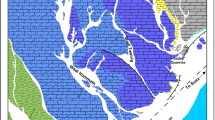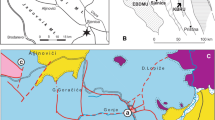Abstract
The paper reports data on the lithogeochemistry of sandstones and silty mudstones from Upper Vendian sedimentary sequences in the northeastern, eastern, and southwestern peripheries of the East European Platform belonging to the so-called unfolded molasse. The sequences are dominated by wackes, arkoses, subarkoses, litharenites, and sublitharenites, i.e., chemically immature and moderately mature psammites, and can be classed with rocks produced by clastic material brought from orogens surrounding the platform. The higher TiO2, Al2O3, FeOtot, MgO, Na2O, and K2O concentrations of the psammites than those in the average cratonic Phanerozoic sandstone (APhSa) testify that the chemical maturing of the rocks was not completed. The silty mudstones accompanying the sandstones have a composition closer to those of the average cratonic Phanerozoic shale (APhSh), but this is likely explained by the fact that the rocks were produced of material brought from erosion territories of much greater area. The lithogeochemical data generally indicate that these territories were dominated by acid and intermediate magmatic rocks with variable fraction of sedimentary rocks when the Late Vendian sedimentary associations in question were produced. The distribution of certain indicator trace elements in the sandstones and silty mudstones show that the average composition of the eroded complexes was close to the composition of the post-Archean upper continental crust, but the erosion areas occasionally (in the Vychegorskii trough and the Shkapovsko-Shikhanskaya depression) contained relatively primitive source rocks. The data points of the great majority of the sandstones and silty mudstones plot in the SiO2-K2O/Na2O and F1–F2 diagrams in the fields of sediments typical of the environments of active continental margins, which is consistent with the arrangement of the data points of these rocks in the La-Th-Sc, Th-Sc-Zr/10, and Th-Co-Zr/10 diagrams. All of these features confirm that the sedimentary rocks in question affiliate with rock associations produced at an active tectonic regime.
Similar content being viewed by others
References
E. M. Aksenov, “The Vendian in the East European Platform,” in Vendian System (Nauka, Moscow, 1985), Vol. 2, pp. 3–34 [in Russian].
Geology and Petroleum Potential of Riphean and Vendian Sediments in the Volga-Ural Province, Ed. by M. M. Aliev, S. G. Morozov, I. E. Postnikova, et al. (Nedra, Moscow, 1977) [in Russian].
Vendian System. Historical-Geological and Paleontological Substantiation. Vol. 2. Stratigraphy and Geological Processes, Ed. by B. S. Sokolov and M. A. Fedonkin (Nauka, Moscow, 1985) [in Russian].
T. V. Belokon’, V. I. Gorbachev, and M. M. Balashova, Structure and Petroleum Potential of the Riphean-Vendian Sediments of the Eastern Russian Platform (IPK “Zvezda”, Perm, 2001) [in Russian].
A. V. Sochava, “Petrochemistry of Vendian Terrigenous Sediments of the Russian Platform and Its Folded Surroundings,” in Proceedings of Conference on the Paleogeography of the Vendian-Early Paleozoic (PVRP-96) (IGG UrO RAN, Yekaterinburg, 1996), pp. 146–149 [in Russian].
Map of the Precambrian Formations of the Russian Platform and Its Folded Framing (with Removed Phanerozoic Deposits) on a Scale 1: 2 500 000. Explanatory Notes, Ed. by Yu. R. Bekker (VSEGEI, Leningrad, 1983) [in Russian].
Yu. R. Bekker, Precambrian Molasses (Nedra, Leningrad, 1988) [in Russian].
H. Tanner, “Beitrag zur Geologie der Molasse zwischen Ricken und Hornli,” Mitteilungen des Geologischen Instituts ETH und Universitt Zrich C/22, 108 (1944).
K. Lemcke, W. von Engelhardt, and H. Fchtbauer, “Geologische und Sedimentpetrographische Untersuchungen im Westteil der Ungefalteten Molasse des Sddeutschen Alpenvorlandes,” Beiheft des Geologischen Jahrbuchs 11, 1–182 (1953).
G. A. Mizens, “On the Stages of Formation of the Uralian Foredeep,” Geotectonics 31(5), 374–385 (1997a).
G. A. Mizens, Upper Paleozoic Flysch of the West Urals (IGG UrO RAN, Yekaterinburg, 1997) [in Russian].
E. M. Aksenov, Histoy of Geological Evolution of the East European Platform in the Late Proterozoic, Doctoral Dissertation in Geology and Mineralogy (IGGD RAN, St. Petersburg, 1998) [in Russian].
E. M. Aksenov, B. M. Keller, B. S. Sokolov, L. F. Solontsov, P. L. Shul’ga, “General Stratigraphic Chart for the Upper Precambrian in the Russian Platform,” Izv. Akad. Nauk SSSR, Ser. Geol., No. 12, 17–34 (1978).
E. M. Aksenov, V. G. Izotov, L. M. Sitdikova, and N. S. Gatiyatullin, “Sequence Stratigraphic Analysis of the Riphean-Vendian Formations of the Kama-Bel’sk and Sergiev-Abdulin Aulacogens,” in Stratigraphy, Paleontology, and Petroleum Potential of the Riphean and Vendian of the Eastern Part of the East-European Platform (IG UNTs RAN, Ufa, 1999), Vol. 2, pp. 3–4 [in Russian].
A. V. Sochava, L. V. Korenchuk, E. A. Pirrus, and S. B. Felitsyn, “Geochemistry of the Upper Vendian Sediments of the Russian Platform,” Litol. Polezn. Iskop., No. 2, 71–89 (1992).
D. V. Grazhdankin, A. V. Maslov, M. T. Krupenin, and Yu. L. Ronkin, Sedimentary Systems of the Sylvitsa Group (Upper Vendian of the Middle Urals) (UrO RAN, Yekaterinburg, 2010) [in Russian].
A. V. Maslov, D. V. Grazhdankin, V. N. Podkovyrov, Yu. L. Ronkin, and O. P. Lepikhina, “Composition of Sediment Provenances and Patterns in Geological History of the Late Vendian Mezen Basin,” Lithol. Miner. Resour. 43(3), 260–280 (2008).
A. V. Maslov, D. V. Grazhdankin, V. N. Podkovyrov, M. V. Isherskaya, M. T. Krupenin, G. A. Petrov, Yu. L. Ronkin, E. Z. Gareev, and O. P. Lepikhina, “Provenance Composition and Features of Geological Evolution of the Late Vendian Foreland Basin of the Timan Orogen,” Geochem. Int. 47(12), 1212–1233 (2009).
D. V. Grazhdankin, “Structure and Depositional Environment of the Vendian Complex in the Southeastern White Sea Area,” Stratigr. Geol. Correlation 11(4), 313–331 (2003).
M. M. Herron, “Geochemical Classification of Terrigenous Sands and Shales from Core Or Log Data,” J. Sed. Petrol. 58, 820–829 (1988).
Ya. E. Yudovich and M. P. Ketris, Principles of Lithochemistry (Nauka, St. Petersburg, 2000) [in Russian].
K. C. Condie, “Chemical Composition and Evolution of the Upper Continental Crust: Contrasting Results from Surface Samples and Shales,” Chem. Geol. 104, 1–37 (1993).
R. L. Rudnik and S. Gao, “Composition of the Continental Crust,” Treatise on Geochemistry 3, 1–64 (2003).
H. W. Nesbitt and G. M. Young, “Early Proterozoic Climates and Plate Motions Inferred from Major Element Chemistry of Lutites,” Nature 299, 715–717 (1982).
B. D. Roser and R. J. Korsch, “Determination of Tectonic Setting of Sandstone-Mudstone Suites Using SiO2 Content and K2O/Na2O Ratio,” J. Geol. 94, 635–650 (1986).
S. R. Taylor and S. M. McLennan, The Continental Crust: Its Composition and Evolution (Blackwell, Oxford, 1985).
X. X. Gu, “Geochemical Characteristics of the Triassic Tethys-Turbidites in Northwestern Sichuan, China: Implications for Provenance and Interpretation of the Tectonic Setting,” Geochim. Cosmochim. Acta 58, 4615–4631 (1994).
B. N. Nath, H. Kunzendorf, and W. L. Pluger, “Influence of Provenance, Weathering and Sedimentary Processes on the Elemental Ratios of the Fine-Grained Fraction of the Bedload Sediments from the Vembanad Lake and the Adjoining Continental Shelf, Southwest Coast of India,” J. Sed. Res 70(5), 1081–1094 (2000).
M. R. Bhatia, “Plate Tectonics and Geochemical Composition of Sandstones,” J. Geol. 91, 611–627 (1983).
M. R. Bhatia and K. A. W. Crook, “Trace Element Characteristics of Graywackes and Tectonic Setting Discrimination of Sedimentary Basins,” Contrib. Mineral. Petrol. 92, 181–193 (1986).
B. D. Roser and R. J. Korsch, “Provenance Signatures of Sandstone-Mudstone Suites Determined Using Discriminant Function Analysis of Major-Element Data,” Chem. Geol. 67, 119–139 (1988).
R. L. Cullers, “Implications of Elemental Concentrations for Provenance, Redox Conditions, and Metamorphic Studies of Shales and Limestones near Pueblo, CO, USA,” Chem. Geol. 191, 305–327 (2002).
D. M. Dobson, G. R. Dickens, and D. K. Rea, “Terrigenous Sediments on Ceara Rise: A Cenozoic Record of South American Orogeny and Erosion,” Palaeogeogr. Palaeoclimat. Palaeoecol 165, 215–229 (2001).
Riphean Stratotype. Stratigraphy. Geochronology, Ed. by B. M. Keller and N. M. Chumakov (Nauka, Moscow, 1983) [in Russian].
Stratigraphic Scheme of the Riphean and Vendian Deposits of the Volga-Ural Area. Explanatory Note, Ed. by E. M. Aksenov and V. I. Kozlov (IG UNTs RAN, Ufa, 2000) [in Russian].
D. V. Grazhdankin and A. V. Krayushkin, “Trace Fossils and the Upper Vendian Boundary in the Southeastern White Sea Region,” Dokl. Earth Sci. 416(4), 1027–1031 (2007).
T. M. Sokur, “Petrochemical Characteristics and Geodynamic Setting of the Formation of the Upper Vendian Sandstones on the Southwestern Margin of the East European Platform,” Geol. Zh., No. 1, 63–71 (2008).
I. E. Postnikova, Upper Precambrian of the Russian Plate and Its Petroleum Potential (Nedra, Moscow, 1977) [in Russian].
N. S. Lagutenkova and I. K. Chepikova, Upper Precambrian Deposits of the Volga-Ural Area and Their Petroleum Prospects (Nauka, Moscow, 1982) [in Russian].
V. G. Olovyanishnikov, Upper Precambrian of the Timan and Kanin Peninsulas (UrO RAN, Yekaterinburg, 1998) [in Russian].
Graywackes, Ed. by V. D. Shutov (Nauka, Moscow, 1972) [in Russian].
Ya. E. Yudovich, M. P. Ketris, and E. Z. Gareev, “Nature of Anomalous Potassium Accumulation in Clay Rocks,” Geokhimiya, No. 5, 689–700 (1991).
N. A. Malyshev, Extended Abstracts of Doctoral Dissertation in Geology and Mineralogy (IG Komi NTs UrO RAN, Syktyvkar, 2000).
A. M. Nikishin, A. V. Furne, and P. Tsigler, “Riphean-Vendian Geological History and Geodynamics of the East-European Craton,” Vestn. Mosk. Gos. Univ. Ser 4: Geol., No. 4, 12–22 (1997).
V. N. Puchkov, Paleogeodynamics of the South and Middle Urals (Dauriya, Ufa, 2000) [in Russian].
L. R. M. Cocks and T. H. Torsvik, “Baltica from the Late Precambrian to Mid Palaeozoic Times: The Gain and Loss of a Terrane’s Identity,” Earth-Sci. Rev. 72, 39–66 (2005).
N. B. Kuznetsov, “The Cambrian Baltica-Arctida Collision, Pre-Uralide-Timanide Orogen, and Its Erosion Products in the Arctic,” Dokl. Earth Sci. 411, 1375–1380 (2006).
N. B. Kuznetsov, “Cambrian Baltica-Arctida Collision: An Initial Stage of Assembly of the Northern Part of the Late Paleozoic-Early Mesozoic Pangea,” Byull. Mosk. O-va Ispyt. Prir., Otd. Geol. 84(1), 18–38 (2009).
N. B. Kuznetsov, Extended Abstracts of Doctoral dissertation in Geology and Mineralogy (IFZ RAN, Moscow, 2009).
N. B. Kuznetsov, A. A. Soboleva, O. V. Udoratina, M. V. Gertseva, V. L. Andreichev, N. S. Dorokhov, “Pre-Uralian Tectonic Evolution of the Northeastern and Eastern Framing of the East European Platform: paper 2: Late Precambrian-Cambrian Collision between Baltica and Arctida,” Litosfera, No. 1, 32–46 (2007).
Author information
Authors and Affiliations
Corresponding author
Additional information
Original Russian Text © A.V. Maslov,V.P. Podkovyrov, 2013, published in Geokhimiya, 2013, Vol. 51, No. 1, pp. 50–71.
Rights and permissions
About this article
Cite this article
Maslov, A.V., Podkovyrov, V.P. Late Vendian unfolded Molasse in the northeastern, eastern, and southwestern peripheries of the east European platform: Distinctive lithogeochemical features. Geochem. Int. 51, 44–64 (2013). https://doi.org/10.1134/S0016702912110080
Received:
Accepted:
Published:
Issue Date:
DOI: https://doi.org/10.1134/S0016702912110080




